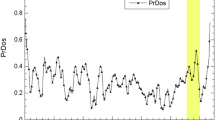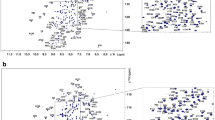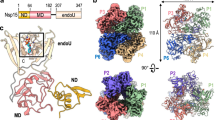Abstract
The non structural protein 5A (NS5A) regulates the replication of the hepatitis C viral RNA through a direct molecular interaction of its domain 2 (NS5A-D2) with the RNA dependent RNA polymerase NS5B. Because of conflicting data in the literature, we study here this molecular interaction using fluorinated versions of the NS5A-D2 protein derived from the JFH1 Hepatitis C Virus strain. Two methods to prepare fluorine-labelled NS5A-D2 involving the biosynthetic incorporation of a 19F-tryptophan using 5-fluoroindole and the posttranslational introduction of fluorine by chemical conjugation of 2-iodo-N-(trifluoromethyl)acetamide with the NS5A-D2 cysteine side chains are presented. The dissociation constants (KD) between NS5A-D2 and NS5B obtained with these two methods are in good agreement, and yield values comparable to those derived previously from a surface plasmon resonance study. We compare benefits and limitations of both labeling methods to study the interaction between an intrinsically disordered protein and a large molecular target by 19F NMR.




Similar content being viewed by others
References
Bessa LM et al (2017) NMR reveals the intrinsically disordered domain 2 of NS5A protein as an allosteric regulator of the hepatitis C virus RNA polymerase NS5B. J Biol Chem 292(44):18024–18043
Campos-Olivas R, Aziz R, Helms GL, Evans JN, Gronenborn AM (2002) Placement of 19F into the center of GB1: effects on structure and stability. FEBS Lett 517:55–60
Crowley PB, Kyne C, Monteith WB (2012) Simple and inexpensive incorporation of 19F-Tryptophan for protein NMR spectroscopy. Chem Commun 48:10681
Curtis-Marof R et al (2014) 19F NMR spectroscopy monitors ligand binding to recombinantly fluorine-labelled b′x from human protein disulphide isomerase (hPDI). Org Biomol Chem 12:3808
Davis MR, Dougherty DA, (2015) Cation-π interactions: computational analyses of the aromatic box motif and the fluorination strategy for experimental evaluation. Phys Chem Chem Phys PCCP 17:29262–29270
Dujardin M et al (2015) A proline-tryptophan turn in the intrinsically disordered domain 2 of NS5A protein is essential for hepatitis C virus RNA replication. J Biol Chem 290:19104–19120
Fernandes F et al (2007) Sensitivity of hepatitis C virus to cyclosporine A depends on nonstructural proteins NS5A and NS5B. Hepatology 46:1026–1033
Frueh DP, Goodrich AC, Mishra SH, Nichols S (2013) R. NMR methods for structural studies of large monomeric and multimeric proteins. Curr Opin Struct Biol 23:734–739
Furukawa A, Konuma T, Yanaka S, Sugase K (2016) Quantitative analysis of protein-ligand interactions by NMR. Prog Nucl Magn Reson Spectrosc 96:47–57
Gerig JT (1994) Fluorine NMR of proteins. Prog Nucl Magn Reson Spectrosc 26:293–370
Hanoulle X et al (2009) Hepatitis C virus NS5A protein is a substrate for the peptidyl-prolyl cis/trans isomerase activity of cyclophilins A and B. J Biol Chem 284:13589–13601
Hanoulle X, Badillo A, Verdegem D, Penin F, Lippens G (2010) The domain 2 of the HCV NS5A protein is intrinsically unstructured. Protein Pept Lett 17:1012–1018
Isley WC, Urick AK, Pomerantz WCK, Cramer CJ (2016) Prediction of (19)F NMR chemical shifts in labeled proteins: computational protocol and case study. Mol Pharm 13:2376–2386
Kelly AE, Ou HD, Withers R, Dötsch V (2002) Low-conductivity buffers for high-sensitivity NMR measurements. J Am Chem Soc 124:12013–12019
Kitevski-LeBlanc JL, Prosser RS (2012) Current applications of 19F NMR to studies of protein structure and dynamics. Prog Nucl Magn Reson Spectrosc 62:1–33
Lippens G, Caron L, Smet, C (2004) A microscopic view of chemical exchange: Monte Carlo simulation of molecular association. Concepts Magn Reson Part A 21A:1–9
Marsh ENG, Suzuki Y (2014) Using 19 F NMR to probe biological interactions of proteins and peptides. ACS Chem Biol 9:1242–1250
Ngure M et al (2016) Interactions of the disordered domain II of hepatitis C virus NS5A with cyclophilin A, NS5B, and viral RNA show extensive overlap. ACS Infect Dis 2:839–851
Palmer AG, Rance M, Wright PE (1991) Intramolecular motions of a zinc finger DNA-binding domain from Xfin characterized by proton-detected natural abundance carbon-13 heteronuclear NMR spectroscopy. J Am Chem Soc 113:4371–4380
Pellecchia M (2005) Solution nuclear magnetic resonance spectroscopy techniques for probing intermolecular interactions. Chem Biol 12:961–971
Pervushin K, Riek R, Wider G, Wüthrich K (1997) Attenuated T2 relaxation by mutual cancellation of dipole-dipole coupling and chemical shift anisotropy indicates an avenue to NMR structures of very large biological macromolecules in solution. Proc Natl Acad Sci USA 94:12366–12371
Robida JM, Nelson HB, Liu Z, Tang H (2007) Characterization of hepatitis C virus subgenomic replicon resistance to cyclosporine in vitro. J Virol 81:5829–5840
Rosnoblet C et al (2012) Hepatitis C virus NS5B and host cyclophilin A share a common binding site on NS5A. J Biol Chem 287:44249–44260
Salwiczek M, Nyakatura EK, Gerling UIM, Ye S, Koksch B (2012) Fluorinated amino acids: compatibility with native protein structures and effects on protein–protein interactions. Chem Soc Rev 41:2135–2171
Sharaf NG, Gronenborn AM (2015) (19)F-modified proteins and (19)F-containing ligands as tools in solution NMR studies of protein interactions. Methods Enzymol 565:67–95
Takeuchi K, Wagner G (2006) NMR studies of protein interactions. Curr Opin Struct Biol 16:109–117
Teilum K, Kunze MBA, Erlendsson S, Kragelund BB (2017) (S)Pinning down protein interactions by NMR. Protein Sci Publ Protein Soc 26:436–451
Tellinghuisen TL, Foss KL, Treadaway JC, Rice CM (2008) Identification of residues required for RNA replication in domains II and III of the hepatitis C virus NS5A protein. J Virol 82:1073–1083
Ye L, Larda ST, Frank Li YF, Manglik A, Prosser RS (2015) A comparison of chemical shift sensitivity of trifluoromethyl tags: optimizing resolution in 19F NMR studies of proteins. J Biomol NMR 62:97–103
Zhu L et al (2015) Conformational change study of dengue virus NS2B-NS3 protease using 19F NMR spectroscopy. Biochem Biophys Res Commun 461:677–680
Acknowledgements
The NMR facilities were funded by the Région Nord-Pas de Calais, CNRS, Pasteur Institute of Lille, European Community (FEDER), French Research Ministry and the University of Lille—Sciences and Technologies. The work was supported by French National Agency for Research Grant ANR-11-JSV8-005 and French National Agency for Research on AIDS and Viral Hepatitis Grant A02014-2. We thanks the Research Federation FRABio (Université de Lille, CNRS, FR 3688, FRABio, Biochimie Structurale et Fonctionnelle des Assemblages Biomoléculaires) for providing the scientific and technical environment conducive to achieving this work.
Author information
Authors and Affiliations
Corresponding author
Rights and permissions
About this article
Cite this article
Dujardin, M., Cantrelle, FX., Lippens, G. et al. Interaction study between HCV NS5A-D2 and NS5B using 19F NMR. J Biomol NMR 70, 67–76 (2018). https://doi.org/10.1007/s10858-017-0159-9
Received:
Accepted:
Published:
Issue Date:
DOI: https://doi.org/10.1007/s10858-017-0159-9




